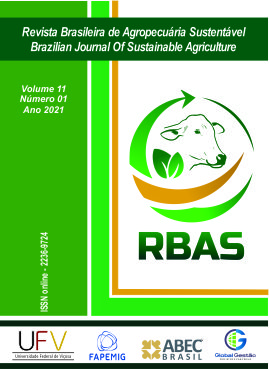Annual cycle of reproduction of bullfrogs in the state of Rio de Janeiro
ANNUAL CYCLE OF REPRODUCTION OF BULLFROGS IN THE STATE OF RIO DE JANEIRO
DOI:
https://doi.org/10.21206/rbas.v11i1.10433Keywords:
Desova, Gametas, Girinos, RaniculturaAbstract
Raniculture is an activity already established in the state of Rio de Janeiro, but it has an obstacle in its productive chain, as in most Brazilian states, which interrupts the reproduction of frogs during the low temperature period (autumn and winter). The reality of the lack of studies in the area of ??bullfrog reproducers, the present study had as main objective to study the reproductive cycle of the reproducers in acclimatized conditions for a year. Adapted was a reproduction sector in a ranário in the state of Rio de Janeiro. During the period of one year, bullfrog males and females were sampled and placed in an adapted experimental stall, the frogs were fed and evaluated through biometrics. In the stall the water temperature controlled at 25 ° C, a photoperiod of 14 hours of light and 10 hours of darkness and humidity of 80%, each animal was considered a repetition. Periodic semen collections and attempts at artificial fertilization with the hormone Buserelin Acetate were performed periodically to induce sexual gametes. In the period from August to June artificial fertilizations were carried out, in just two months, in December four females were fit and in March five females, males from November were already fit. In June he completed the stall with five females and 10 males, that is, a little more than half. Only three spawns hatched and resulted in tadpoles, 5,850 in total and an average of 1,950 per spawn.
Downloads
Downloads
Published
How to Cite
Issue
Section
License
Copyright (c) 2021 Brazilian Journal of Sustainable Agriculture

This work is licensed under a Creative Commons Attribution-NonCommercial-NoDerivatives 4.0 International License.
1. Proposta de Política para Periódicos de Acesso Livre
Autores que publicam nesta revista concordam com os seguintes termos:
Autores mantém os direitos autorais e concedem à revista o direito de primeira publicação, com o trabalho simultaneamente licenciado sob a Licença Creative Commons Attribution que permite o compartilhamento do trabalho com reconhecimento da autoria e publicação inicial nesta revista.












